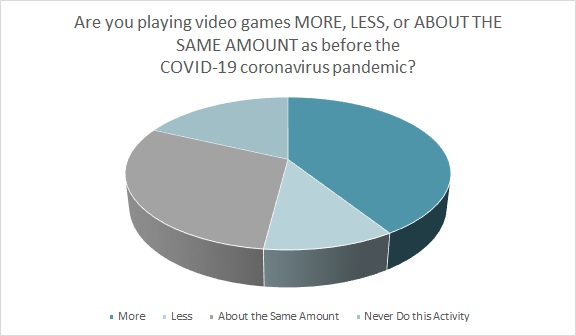Brands Connecting Through Gaming
“Nobody on the road
Nobody on the beach
I feel it in the air
The summer’s out of reach”
Let’s face it: everything is weird now. Major League Baseball’s “Boys of Summer,” who Don Henley alludes to in that old soft rock hit, didn’t even start their season. The COVID-19 pandemic put the clamp on the NBA and NHL seasons, as well. Schools are closed and students are distance learning while their parents work nearby — if they haven’t yet been furloughed. With orders to stay at home, it’s hardly a surprise that video games are serving as a distraction from the news, as well as helping people pass the time and connect with others. And that’s why the games might actually be a good place for brands to keep in touch with consumers via in-game advertising.
As we look into the future, we anticipate an increasing amount of both product placement and ability-to-purchase embedded directly into the gaming experience…The trick will be to do it in a subtle and seamless way. Nobody wants a clunky experience when trying to buy something.
Rob Garf
Vice President of Strategy and Insights for Retail & Consumers Goods, Salesforce
Consumers spent 65 percent more on video games in mid-March compared to the same period last year, according to Andrew Little, a research analyst at Global X, in a CNBC report. In 2018, the video game industry held a value of $130 billion and was expected to reach $300 billion by 2025, according to GlobalData UK, a data analytics and consulting company.
In recent weeks, 41 percent of consumers have been playing video games more than before the COVID-19 outbreak, according to the Cotton Incorporated’s 2020 Coronavirus Response Consumer Survey (Wave 1, March 20-25). Another 30 percent are playing about the same amount, with 11 percent playing less.

Popular titles like Call of Duty: Warzone, Animal Crossing, Doom Eternal and League of Legends have been helping to distract and entertain millions of gamers during lockdown.
Salesforce’s Rob Garf , vice president of strategy and insights for retail and consumers goods, says the gaming industry is big and growing in an interview. And the company’s Connected Shoppers Report shows that while only 4 percent of shoppers use gaming consoles to buy products today, four times as many (16 percent) are interested in doing so. Among Gen Z, 7 percent currently make purchases with their console, and 25 percent are interested in doing so in the future. Clearly, video games give brands a new opportunity to reach consumers where they’re spending time.
“The key thing here is not to diminish the gaming experience with an intrusive ad,” Garf says. “Options like reward videos, interstitials and banner ads are fine, especially if the game is free, as long as they fit seamlessly into games without interrupting the action — and frustrating players.”
He points to Fortnite, which in 2019 partnered with the NFL to sell virtual jerseys (skins) on the in-game shop, which could be turned into any of the 32 NFL team uniforms.
Additionally, “Nike sponsored a custom game mode on Fortnite where players could skateboard around a city-like environment,” Garf says. “Players could also purchase Air Jordan skins for their characters’ [virtual shoes].”
Candy Crush, the popular game from King.com, is currently partnered with Target for an Easter promotion. When players log on to their opening screen, Target’s bullseye logo is seen on the character Tiffi’s Easter basket, as well as in the background on a bag and, presumably, a Target store. Piles of Easter eggs and candy complete the scene.
Candy Crush can be played online either via a desktop or a phone. Consumers say they’re playing online video games 33 percent more since the coronavirus stay-at-home orders began, according to Cotton Incorporated’s Coronavirus Response Consumer Survey. Another 28 percent say they’re spending the same amount of time playing online video games, including multi-player games.
Garf says 51 percent of mobile gamers are women and the average age of a mobile gamer is 36. He points to data from MoPub in conjunction with Factual research that says the 16-to-24 age group represents just 14.2 percent of mobile gamers, while people over 45 years old make up nearly a third. Among Twitch users, 71 percent are Millennials whose average age is 21, and 82 percent of which are male, according to the review site MuchNeeded.
RapidFire, an in-game advertising network, helps brands connect with players on console, Steam (the video game site), PC, and mobile platforms through customized integration. The company employs a few types of in-game advertising. Dynamic ads take the form of billboards or posters within a 3D video game that can be updated or changed in real-time. Advergaming involves creating an entire game that revolves around or is heavily related to a company, brand, or product. And static ads are like product placement in a movie.
“Static in-game advertising is integrated into the storyline of the game and allows players to interact with the advertisement in question,” states the RapidFire site, which shows a character wearing a T-shirt with the Axe men’s body fragrance logo.
Since the COVID-19 pandemic began, 47 percent of consumers say they have discovered new ways to shop, (e.g. online, delivery services), according to the Cotton Incorporated’s Coronavirus Response Consumer Survey. And 57 percent say, “This experience will change the way I shop in the future.” While consumers may not have in-game shopping in mind when they think about how their shopping habits may change, Garf says it’s an advertising outlet that needs to be considered.
“As we look into the future, we anticipate an increasing amount of both product placement and ability-to-purchase embedded directly into the gaming experience,” he says. “The trick will be to do it in a subtle and seamless way. Nobody wants a clunky experience when trying to buy something.”
